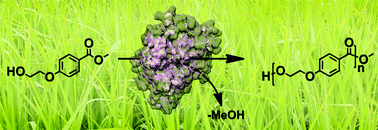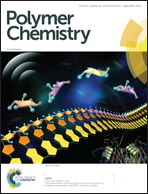Enzymatic approach for the synthesis of biobased aromatic–aliphatic oligo-/polyesters†
Abstract
Aromatic moieties containing oligoesters have been synthesized by enzymatic polymerization of AB-type alkylenehydroxybenzoates via different polymerization methods. Oligo(2-hydroxyethoxy benzoate) (OHEBA) was obtained with number average molecular weights (Mn) around 2000 g mol−1. A low degree of polymerization was achieved or no oligomer formation was observed from the enzymatic reaction of compounds modified by one or more methoxy groups. MALDI-TOF MS analysis suggests that the most dominant species in the resulting HEBA oligomer samples are ester/–OH end groups. The thermal properties of the enzymatically produced oligoesters were fully characterized using DSC, TGA and WAXD as well as rheology studies and have been compared with higher molecular weight polymers prepared by conventional polycondensation reactions from the same p-hydroxy benzoic acid derivative. These semi-crystalline oligomers and polymers were found to be mimicking the thermoplastic aromatic/aliphatic polyester regarding their macromolecular structure and thermal behavior. The molecular weight of the obtained AB-type OHEBA was successfully increased to 13 050 g mol−1 by using it as a macromolecular monomer in sequential polymerization.



 Please wait while we load your content...
Please wait while we load your content...